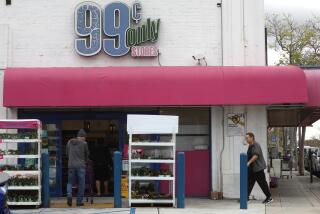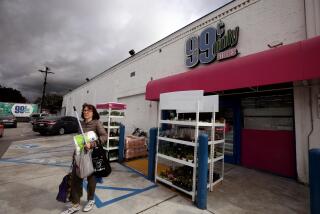Gap Absent From 3 New Taubman Shopping Centers
- Share via
Visitors to three new malls being built by Taubman Centers Inc. won’t find something most shopping-center patrons take for granted: Gap, Banana Republic and Old Navy clothing stores.
The absence is the result of a standoff over rents between Taubman, operator of the most profitable malls, and San Francisco-based Gap Inc., the No. 1 clothing retailer, analysts and industry executives said.
The disagreement tests both Gap’s power over landlords and Taubman’s ability to thrive without retail stores that produce more sales per location than other apparel retailers and help attract shoppers to malls, said real estate and retail industry executives and analysts.
The outcome could be an indication of pricing patterns, they said. “Other retailers are watching these developments closely,” said Kurt Barnard, president of Barnard’s Retail Trend Report.
Rather than meet Gap’s demands for lower payments, Bloomfield Hills, Mich.-based Taubman plans to open three malls, for which it is paying $553 million of the $750-million cost, without any of the retailer’s popular stores. The first, the Shops at Willow Bend, in Plano, Texas, opened this month.
“Taubman has basically cut Gap off,” said James Sullivan, a real estate analyst at Prudential Securities.
Gap’s goal, said David Fick, a real estate analyst for Legg Mason Wood Walker, is to reduce total “occupancy costs”--how much it pays in rent and other fees--to 3% of sales from 6%. One way it seeks to do that, real estate executives said, is by asking for a flat monthly fee to cover rent and other mall services rather than paying base rent plus a portion of store sales--”percentage rent”--and separate charges for maintenance and mall advertising. Only major anchor tenants, such as Sears, Roebuck & Co., have received such terms in the past.
Gap is facing slowing sales as demand for its casual fashions slackens. Last week Gap fired 1,000 workers and eliminated 560 unfilled jobs to cut costs. Same-store sales for July, a key barometer for retailers, fell 12% over the year before.
The two largest mall developers--Simon Property Group Inc. and General Growth Properties Inc.--have already capitulated to some of the retailer’s demands, according to Matt Ostrower, an analyst at Morgan Stanley Dean Witter & Co. Billie Scott, a spokeswoman at Simon, and John Bucksbaum, the chief executive of General Growth, declined to comment.
Taubman spokeswoman Barbara Baker said the developer is still negotiating with Gap, which has 50 stores in Taubman malls. “We don’t comment on specific leasing deals,” she said. ‘We are not at liberty to talk about when we signed them or when they expire. We think that Gap is a terrific retailer.”
Stacy MacLean, spokeswoman for Gap, denied there is a dispute with Taubman over rent and said Gap may be absent from the new malls for a variety of reasons. “There are a number of factors Gap looks at, including ZIP Code demographics,” MacLean said.
Taubman could have more to lose by not having Gap stores in its malls than Gap would lose by not being there, said Steven Greenberg, head of Greenberg Group, a real estate consultant to retailers. “It is extremely difficult to have a successful retail center today without a Gap,” he said.
Gap is a lucrative tenant, having generated sales of about $427 a square foot in the fiscal year ended in January, compared with $333 for Sears. Each Gap store, on average, produces $3.65 million in annual sales, twice that of stores of the Limited Inc. chain, the No. 2 apparel retailer.
In addition to producing greater “percentage rents” for mall owners from that higher volume, Gap also brings more traffic to the malls than other retailers through national marketing efforts. In the last three years Gap spent $1.39 billion on advertising, 41% more than Limited, according to Securities and Exchange Commission filings.
“Few retailers would have a leg to stand on if they tried to do what Gap is doing,” said Ostrower at Morgan Stanley.
Taubman is taking the risk of living without Gap at a difficult time for the developer. It is undertaking its biggest one-year expansion since its founding in 1950 by A. Alfred Taubman against the backdrop of a slowing U.S. economy, which is hurting retail sales and mall receipts.
On Friday in New York Stock Exchange trading, Taubman shares rose 10 cents to close at $14.01, and Gap fell 21 cents to close at $25.39.
More to Read
Inside the business of entertainment
The Wide Shot brings you news, analysis and insights on everything from streaming wars to production — and what it all means for the future.
You may occasionally receive promotional content from the Los Angeles Times.










